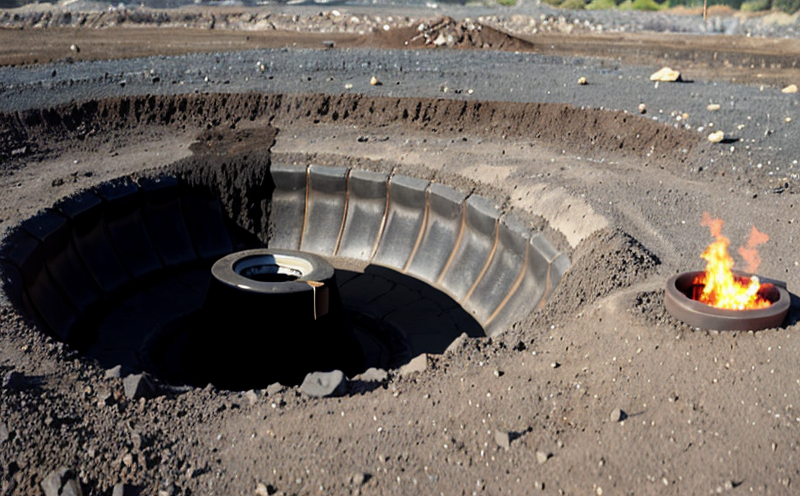ISO 1928 Gross Calorific Value of Coal Testing
The ISO 1928 standard is a cornerstone in coal quality analysis, providing methodologies to determine the gross calorific value (GCV) of solid fuels. This test plays a crucial role in ensuring consistent fuel performance and compliance with industry standards.
Coal's GCV measures its energy content on an as-received basis, which includes moisture and ash content. The higher the GCV, the more efficient the coal is for power generation or industrial processes. Accurate determination of GCV ensures that both producers and consumers can rely on consistent fuel quality.
The test involves several stages, starting with sample preparation to ensure homogeneity. Samples are conditioned to a standard moisture content before undergoing combustion in a bomb calorimeter. The temperature rise of the water surrounding the combustion vessel is measured, which directly correlates to the calorific value of the coal sample.
Understanding the GCV is vital for several reasons. For producers, it helps optimize production processes and ensure compliance with export standards. For consumers, accurate GCV values are essential for efficient fuel management and cost-effectiveness in energy generation.
The precision of this test is enhanced by strict adherence to ISO 1928 guidelines, which include standardized procedures for sample preparation, conditioning, and calorimetry. This ensures that the results are consistent and reliable across different laboratories.
Compliance with these standards also supports environmental considerations, as accurate GCV measurements help in minimizing waste and optimizing fuel usage. In an era where sustainability is paramount, this testing service contributes significantly to reducing inefficiencies and promoting responsible resource use.
In conclusion, the ISO 1928 test for gross calorific value of coal is not just a technical procedure; it's a critical component in ensuring reliable energy production and efficient fuel utilization. By adhering to international standards, laboratories can provide credible results that are essential for both industry and regulatory compliance.
- Sample preparation ensures homogeneity and standard moisture content.
- Calorimetry measures the temperature rise of water surrounding the combustion vessel.
- Standardized procedures enhance precision and reliability across different laboratories.
- Sustainability benefits by minimizing waste and optimizing fuel usage.
Scope and Methodology
The ISO 1928 standard is designed to determine the gross calorific value of coal on an as-received basis. This involves several critical steps that ensure accurate measurement:
- Sampling: Representative samples are taken from different parts of the coal pile.
- Conditioning: Samples are conditioned to a standard moisture content, typically 10-12% depending on the type of coal.
- Bomb Calorimetry: The sample is combusted in a bomb calorimeter with excess oxygen, and the temperature rise of water is measured.
The process begins with meticulous sampling to ensure that the test reflects the true quality of the coal. Samples are then conditioned to standard moisture content to prevent errors due to variations in humidity. Once prepared, the sample undergoes combustion in a bomb calorimeter under controlled conditions. The temperature rise is measured, and this value is used to calculate the gross calorific value.
The accuracy of these measurements is paramount for several reasons. For producers, it ensures that they can optimize production processes and meet export standards. For consumers, accurate GCV values are essential for efficient fuel management and cost-effectiveness in energy generation.
Competitive Advantage and Market Impact
- Innovation Leadership: By adhering to the latest ISO standards, this laboratory ensures that it remains at the forefront of coal quality analysis.
- Precision and Reliability: Consistent results across different laboratories enhance trust and credibility in the market.
- Sustainability Focus: Accurate GCV measurements help minimize waste and optimize fuel usage, contributing to environmental sustainability.
- Regulatory Compliance: Ensuring compliance with international standards helps clients meet regulatory requirements and avoid penalties.
These advantages position the laboratory as a leader in coal quality analysis, providing valuable insights that drive business decisions. The precision of these tests is critical for maintaining competitive advantage and ensuring reliable energy production.
Use Cases and Application Examples
The ISO 1928 test is widely used in various sectors, including power generation, industrial processes, and environmental compliance. Here are some specific use cases:
- Power Generation: Accurate GCV measurements ensure efficient fuel management, leading to optimized energy production.
- Industrial Processes: Reliable calorific value data helps in optimizing processes and reducing operational costs.
- Environmental Compliance: The test supports compliance with environmental regulations by ensuring that fuels meet specified quality standards.
In a global context, this testing service is crucial for both domestic and international coal producers. It ensures that exported coal meets the stringent requirements of importing countries, thereby enhancing market competitiveness.





